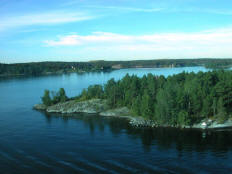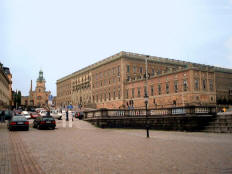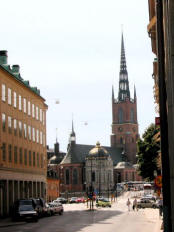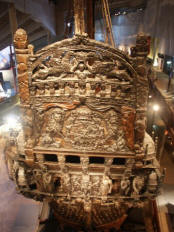Part I - Page 1 2 3 4 5 6 7 Go to: Part II Part III Part IV
STOCKHOLM
Thursday, 18 August. We were up at 7:15 and hurried to the breakfast buffet, only to discover that it wasn’t open yet. “It opens at 7:00,” we were told. This was not a different time zone, and we should not have turned our clocks forward. We regretted that lost hour of sleep, but the error did have us up in time to see the Stockholm Archipelago as our ship sailed through. There are some 24,000 islands of various sizes, and it’s a spectacular experience.
Stockholm is located where Lake Malaren meets the Baltic Sea. Founded as a fortress in the 13th century, it eventually spread to the nearby islands and mainland. Today, it covers 14 islands and several peninsulas, linked by numerous bridges and canals.The ship docked at 9:00 and our tour, A Day in Stockholm, began half an hour later. We had chosen this tour to see as much as possible of the city in the short time we would be here. First the bus took us to Fjallgaten Street for a panoramic view of the inner city and harbor. Several old sailing and steam ships were moored in the harbor.
Our next stop was at the City Hall (Stadshuset) (1923), where our visit included the Blue Room (where the Nobel Prize award dinner [not the award ceremony] is held) and the Gold Room (with its magnificent mosaics).
The bus took us by Central Station (1871), the modern shopping area, the main pedestrian street, the King’s Gardens, and the Opera House.
Crossing the bridge into the Old Town (Gamla Stan), the bus dropped us off in Slottsbacken, a long open area behind the Royal Palace that runs from the Cathedral (Coronation Church) to the harbor.
From there our local guide took us on a walking tour around the area. The high point was Stortorget Square, surrounded by old buildings. We then walked a short block to the Old Church (Storkyrkan, also referred to as the Cathedral)), the city’s oldest structure (late 13th century, but much modified over the years). It has an elaborate statue of St. George slaying a dragon, a.copy of which decorates a nearby square). Our guide finally turned us loose to go to the Royal Palace, right around the corner, for the changing of the guard at noon (the most elaborate ceremony of the day). As might be expected, it was mobbed.
Then we were on our own until 1:30. We’d brought sandwiches from the ship so we’d have more time to explore. We ate right along the canal (Stallkanalen) below the Palace. I’d gotten a few Swedish kronen on the ship, so we were able to get some drinks and ice cream, too.
We had less than an hour left and spent most of that walking the old streets. We saw the Riddarholmen Church (late 11th century), originally a monastery but also the royal burial place for Swedish royalty for 700 years. We didn’t go inside because of the limited time. Back at the Slottsbacken a few minutes early, Jane rested while I walked down the hill for some pictures of the harbor.
The bus took us over to the island of Djurgarden, site of the Skansen Open Air Museum, the Nordic Museum, and the Vasa Museum, as well as other of Stockholm’s attractions. We drove past Skansen, Europe's first open-air folk museum (1891). This 75-acre park has over 150 homes, shops, schools, farms, and churches from all over Sweden. We would have loved to visit it, but there just wasn’t the time.
The Vasa Museum was our destination. The Vasa was a battle galleon built for King Gustavus Adolphus. It was to be the world’s mightiest warship, with two gun decks and 64 bronze cannons. It was brightly painted and decorated with wooden carvings of gods, demons, kings, knights, warriors, cherubs, mermaids, and weird animals. While its size and beauty were wondrous to behold, there was one problem. When the Vasa began her maiden voyage in1628, she capsized and sank before sailing a mile. After some early salvage attempts, the ship was forgotten. Not even a record of her location was preserved. The ship was located again in 1956 and raised in 1961. After years of restoration work, the Vasa Museum opened to the public in 1990.
After watching a film on the history of the Vasa and its restoration, we had about an hour to explore the ship on our own., from three different levels. There were also models of the ship and full scale replicas of some of its decks and interiors. (Visitors are not allowed aboard the Vasa itself.) We left the Museum at 3:15, and the bus drove us around some more of the city. We went through Embassy Row, and past the House of Nobles (Riddarhuset) and the Riddarholmen Church. We finally got to the ship about 4:15, pretty worn out after nearly seven hours on the tour. The ship sailed at 5:00. Dinner was uneventful, i.e., no escargot. We enjoyed the view of the Stockholm archipelago as we ate. Afterward we bought a couple of rings for Jane at the “massive jewelry sale” in the Jewelry & Watch Boutique. Then we went to the 8:45 show. The show featured a woman (noticeably pregnant) who had starred in musicals in London’s West End. She was great. Before retiring, we set our clocks forward again, this time correctly.
Part I - Page 1 2 3 4 5 6 7 Go to: Part II Part III Part IV |


























